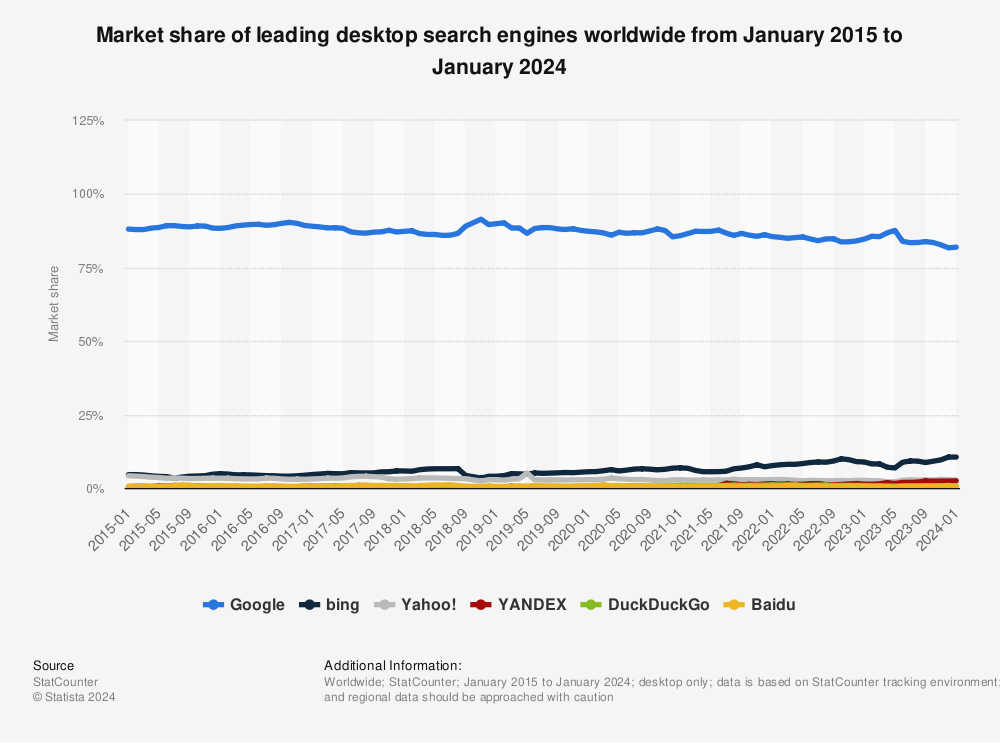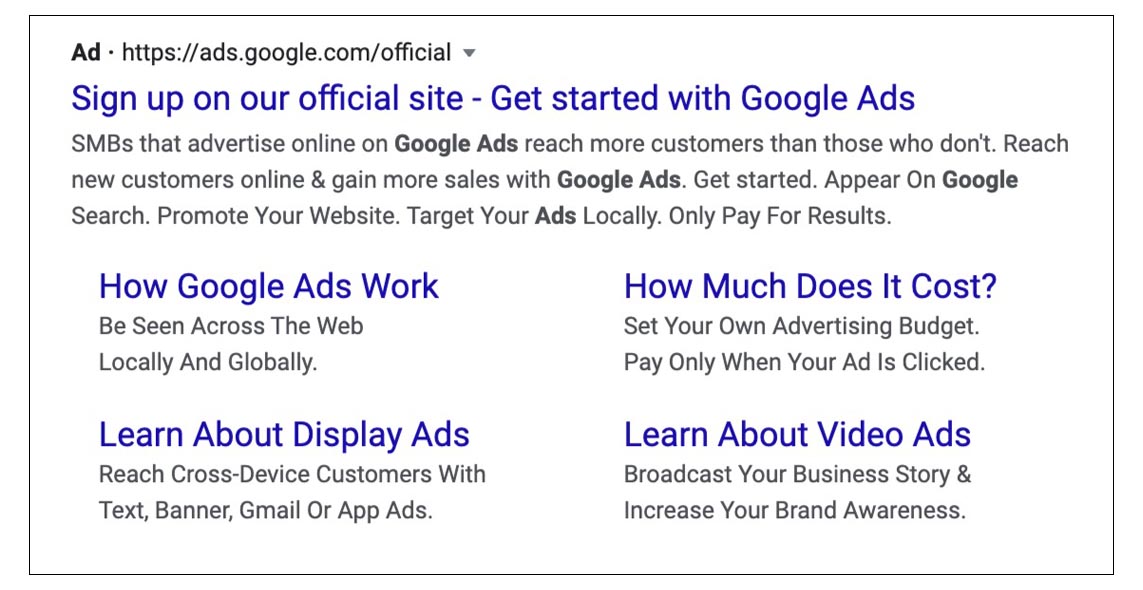Summary – In this post, we’ll show you how to improve the effectiveness of your Google Adwords by understanding ad quality score and optimizing your PPC landing pages.
Now known as Google search ads, Google Adwords campaigns are crucial to digital marketing.
Google remains the biggest search engine with close to 90% market share of desktop searches, according to Statista:

With pay per click campaigns being a key component of a holistic sem, seo and cro strategy, it’s also important to make sure that your Google Ads actually work. That is, that they’re click-worthy and at the same time optimized for conversions.
Most companies have no problem with creating attractive enough ads. Where a lot of them fail is in the conversion optimization part.
In this post, we’ll show you how to improve the effectiveness of your Google Adwords by understanding ad quality score and optimizing your PPC landing pages.
Are Google Adwords Effective?
A lot of businesses are hesitant to try Google Adwords. Campaigns can be costly so business owners naturally want to know if these are effective.
The short answer is yes. Google Ads are effective at getting people to your site and generating leads. Clutch, for instance, says that 63% of online users have clicked on a Google ad.
There’s a caveat, of course: You have to know what you’re doing to avoid wasting your advertising dollars.
What makes Google Adwords effective is that it’s intent-based. Your ads will only show up when the search activity is aligned with your choice of keywords. So you’d want to create ads and choose keywords that are actually used by people who are looking for your product or service.
Google also lets you set your own bids (called manual bidding) so you can start with a very modest budget. Google’s algorithm actually learns from the performance of your ads to determine the best placements in terms of relevance.
Google Adwords can be very useful especially for newer sites that need a traffic boost. Search engine optimization can take a while so investing in paid traffic is a good idea if you don’t want to wait around for your SEO to finally start working.
That said, paid campaigns are even more valuable for established brands and companies. You’ll find that a lot of the big brands are among the highest ppc spenders. These companies know that you need to invest in marketing if you want to sell more and grow your business.
But to ensure you get the most out of your Adwords spend, you also need to have a conversion-optimized experience. How effective your Google Adwords would be in turning your search ad clicks into actual customers depends on how well your website and landing pages do the job. Your ads may be persuasive enough to get clicks, but those clicks will be wasted if you didn’t do a good enough job of designing these pages for conversion.
Google Adwords Campaigns That Convert
Let’s make it clear: Google Adwords campaigns are conversion activities.
Getting people to click through from the ad to the page is a conversion. Getting the visitor from the landing page to the desired next step is a conversion activity. Completing the transaction with a user is a conversion activity.
To maximize your investment on Google Ads, you have to make sure you’re running optimized campaigns. This way, you can increase your return on ad spend (ROAS) and keep your cost per acquisition (CPA) low.
The key to optimizing Google Ads campaigns is aiming for a higher Quality Score, a keyword-level metric that’s very useful at determining how you can improve the quality and performance of your ads.
Google calculates your Quality Score based on these 3 factors:
- Expected clickthrough rate (CTR)
- Ad relevance
- Landing page experience
If your company is running AdWords campaigns, you need to focus on these for a shot at success:
- Improving your CTR and ad relevance
- Optimizing your landing page experience
Improving CTR and Ad Relevance
Complete Visibility
A lot of companies run multiple AdWords accounts, with separate people running the instances. That’s generally fine, unless one hand cannot see what the other one is doing – which happens more than you might expect.
If your company has multiple AdWords instances, you need complete visibility. That generally requires you to be organized a certain way:
- One Google Analytics account despite multiple AdWords instances. You need to link all your AdWords accounts to the same Google Analytics account. The advantage is that you’ll be able to see if multiple accounts are advertising for the same phrases using different verbiage – this way, you’ll know if you’re cannibalizing your own campaigns. Additionally, you’ll be able to see more of what’s working, so you can tweak your strategy. If you don’t know how to link AdWords to Google Analytics, you can get started here.
- Multiple AdWords accounts under tools like Manager Account. You can also hopefully see bids and efficiency for multiple AdWords accounts from one central place. If you’re not doing this right now, there are tools like Manager Account (formerly My Client Center or MCC) that can do this for you.
Target the Right Keywords
In Google ads, choosing the best keywords is winning half the battle.
As we’ve noted earlier, Google ads are intent-based. You want as much as possible to have keywords that accurately mirror the intent behind the search term. Conversely, you don’t want keywords that are triggered by irrelevant searches.
Use Google’s keyword planner or other keyword tools like Wordstream’s free keyword tool to pick the right keywords. You should be able to map these keywords to the visitor search intent.
You can also use the same tools to identify your negative keywords. It’s crucial that you pay attention to negative keywords if you don’t want to attract unqualified traffic. For instance, if you’re selling fashion jewelry, you don’t want your ads to be displayed when someone searches for “engagement ring.”
Irrelevant keywords not only bring your quality score down but they also waste your budget and tank your conversion rate. Use the negative keywords list to narrow down your searches to the ones that are very much aligned with what you’re offering.
Write Great Headlines and Descriptions
The ad copy has a big influence on your click-through rate.
It needs to be enticing enough to persuade searchers to click.
That said, creating persuasive headlines and descriptions for Google search ads is often easier said than done. Google has character limitations on the headlines and descriptions so it’s important to clearly communicate your unique value proposition early on.

For the headline, you should match the user intent as closely as possible by using the words and phrases that are most likely to be used by your target visitors. The headline is the first thing that searchers will see so it needs to be clear, direct and impactful. It should pique the searcher interest by being relevant to their needs and encourage them to read your entire copy.
Next, write a thoughtful description. As with the headline, you need to be succinct and tell searchers what your product or service is about. Think about what benefit or solution you offer to potential customers and include a call to action.
Properly Set Up Conversion Tracking
Believe it or not, some companies actually run Google ads without setting up conversion tracking.
In an audit of 2000 adwords accounts, Disruptive Advertising found out that almost half (42.3% to be exact) did not have conversion tracking in place. What was even more alarming was that those accounts that were tracking conversions were either tracking meaningless metrics or had improperly configured tracking setups.
This is a terrible mistake you don’t want happening to your own ads.
Without conversion tracking, you’d know you’re getting clicks but you wouldn’t know what happens after the click:
- What searchers did after the click – did they engage or bounced right off your landing page?
- How many of your clicks became customers – what actions did your visitors do on the landing page? What percentage of them purchased or filled out a form?
- Which of your ads worked and which ones didn’t – did your ads persuade visitors to click and then take the desired conversion action?
By monitoring conversion activities, you can detect issues and problems with either your ads or landing pages early on. You’ll have a basis for optimizing your ads and the pages that your online visitors are taken to.
You want to belong to the few who have effective conversion tracking in place. You don’t even need to have advanced coding skills to do this. It’s now easier to track website events through google tag manager and Google Analytics.
Landing Page Experience Best Practices
Messaging Continuity
No matter how engaging your headline is on the landing page for your AdWords campaign, it isn’t going to matter if you fail at this:
The headline of the page needs to tie very closely to the title of the ad.
It seems like a really simple idea, but a lot of companies miss this. Some organizations don’t bother creating landing pages at all, deep-linking AdWords ads into a sort of related section on the web site. Others create a landing page for multiple AdWords campaigns, so the headline can’t match the specific ad as there are a ton of them.
Don’t fall into that trap. Make sure your landing page matches your AdWords messaging. That’s true for the content on the body of the page as well, but it’s extremely critical for the headline.
Your bounce rate for paid traffic will give you headaches if you don’t focus on messaging continuity between the ad and the page.

Need Help designing your landing pages?
Specialized Messaging
On that same note, make sure your campaign landing page isn’t trying to serve too many masters. Focus on a few items:
- The page matches the ad closely
- The next set of actions that you want the users to take are clear
- There are very few distractions
If you’re trying to save money by creating fewer landing pages, (or worse, no landing pages at all, just deep linking ads into pre-existing sections of the site) check the efficiency of the pages you’re sending them to. You might be disappointed that you’re not actually saving anything, just consuming your AdWords budget with very little to show for it.
Limited Conversion Activities
Finally, even on specialized landing pages that match the ad very closely, you can’t let your user choose from eight different actions.
One very clear call to action is ideal; if that’s not manageable, you can have a primary action, and a secondary action. When you do have two possible actions, make sure they are both from similar stages in the buying cycle.
You can’t expect to promote your early stage PDF, your middle of the funnel trial software, and the late stage price points and cart in one landing page. All that will do is make the case very poorly on all fronts.
Putting it All Together
There are a ton of organizations that manage AdWords campaigns very poorly. Depending on your space, that might be an opportunity.
If you’re looking to maximize a very limited ad budget, focus your efforts on improving the CTR of your ads and optimizing the landing page experience. These two factors have the biggest impact on your ad quality score. Not only that, your click-through rates and landing page experience are indicative of the effectiveness and relevance of your search ads.
Last but not the least, properly implement your conversion tracking. By doing so, you are empowering your company to make data-driven decisions that can help you succeed in your Google search ads campaigns.
Subscribe to the SiteTuners Weekly Email
Grow Your Business
Exponentially with Proven
Conversion Rate
Optimization Expertise.


